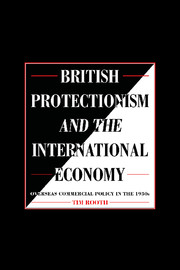Book contents
- Frontmatter
- Contents
- Preface
- List of Tables
- Introduction
- 1 Britain's international economic position in the 1920s
- 2 The political economy of protectionism
- 3 Imperial preference and the Ottawa Conference
- 4 The Scandinavian negotiations: formulation of policy
- 5 Completion of the first phase of negotiations: Scandinavia, Germany and Argentina
- 6 The world economic conference, Finland and Japanese competition
- 7 The Baltic states and Poland
- 8 British agricultural policy and imports during the 1930s
- 9 British exports to the trade agreement countries
- 10 Appeasing Germany and the United States
- 11 Some general conclusions
- Appendix A United Kingdom: payments, clearing etc., Agreements in force 1931–1938
- Appendix B Miscellaneous trade and payments agreements
- Appendix C Imports into Britain from foreign agreement countries
- Appendix D Total exports from Britain to foreign agreement countries and four dominions
- Appendix E Imports of selected commodities into UK, 1931, 1937, showing percentage from Empire sources
- Bibliography
- Index
9 - British exports to the trade agreement countries
Published online by Cambridge University Press: 06 July 2010
- Frontmatter
- Contents
- Preface
- List of Tables
- Introduction
- 1 Britain's international economic position in the 1920s
- 2 The political economy of protectionism
- 3 Imperial preference and the Ottawa Conference
- 4 The Scandinavian negotiations: formulation of policy
- 5 Completion of the first phase of negotiations: Scandinavia, Germany and Argentina
- 6 The world economic conference, Finland and Japanese competition
- 7 The Baltic states and Poland
- 8 British agricultural policy and imports during the 1930s
- 9 British exports to the trade agreement countries
- 10 Appeasing Germany and the United States
- 11 Some general conclusions
- Appendix A United Kingdom: payments, clearing etc., Agreements in force 1931–1938
- Appendix B Miscellaneous trade and payments agreements
- Appendix C Imports into Britain from foreign agreement countries
- Appendix D Total exports from Britain to foreign agreement countries and four dominions
- Appendix E Imports of selected commodities into UK, 1931, 1937, showing percentage from Empire sources
- Bibliography
- Index
Summary
British export performance has to be seen in the context of the dismal record of world trade as a whole during the 1930s. Even in the peak year, 1937, world trade, whether measured by volume or value, was still below the level of 1929, although world production both of primary commodities and of manufactures was higher than it had been before the depression. International trade in primary products was better maintained than that in manufactured goods, although there was no dramatic shift in the proportion between the two categories. In 1927 manufactured goods comprised 38·4 per cent of world trade, and in 1937 they accounted for 36·5 per cent. Alfred Maizels estimates that world exports of manufactures in constant (1955) prices were £19,895 million in 1937, still 16·6 per cent below the 1929 level of £23,841 million.
The greatest absolute and relative contraction in imports of manufactured goods was into the markets of the industrial countries. By 1937 the volume of world manufactured exports to this group was 29 per cent below the amount in 1929. The other principal groups of countries, the semi-industrial and the ‘rest of the world’, had proved to be more resilient markets. In 1937 world exports of manufactures to the semi-industrial countries were 14 per cent below the 1929 volume, while those to the ‘rest of the world’ had increased marginally.
- Type
- Chapter
- Information
- British Protectionism and the International EconomyOverseas Commercial Policy in the 1930s, pp. 239 - 274Publisher: Cambridge University PressPrint publication year: 1993



